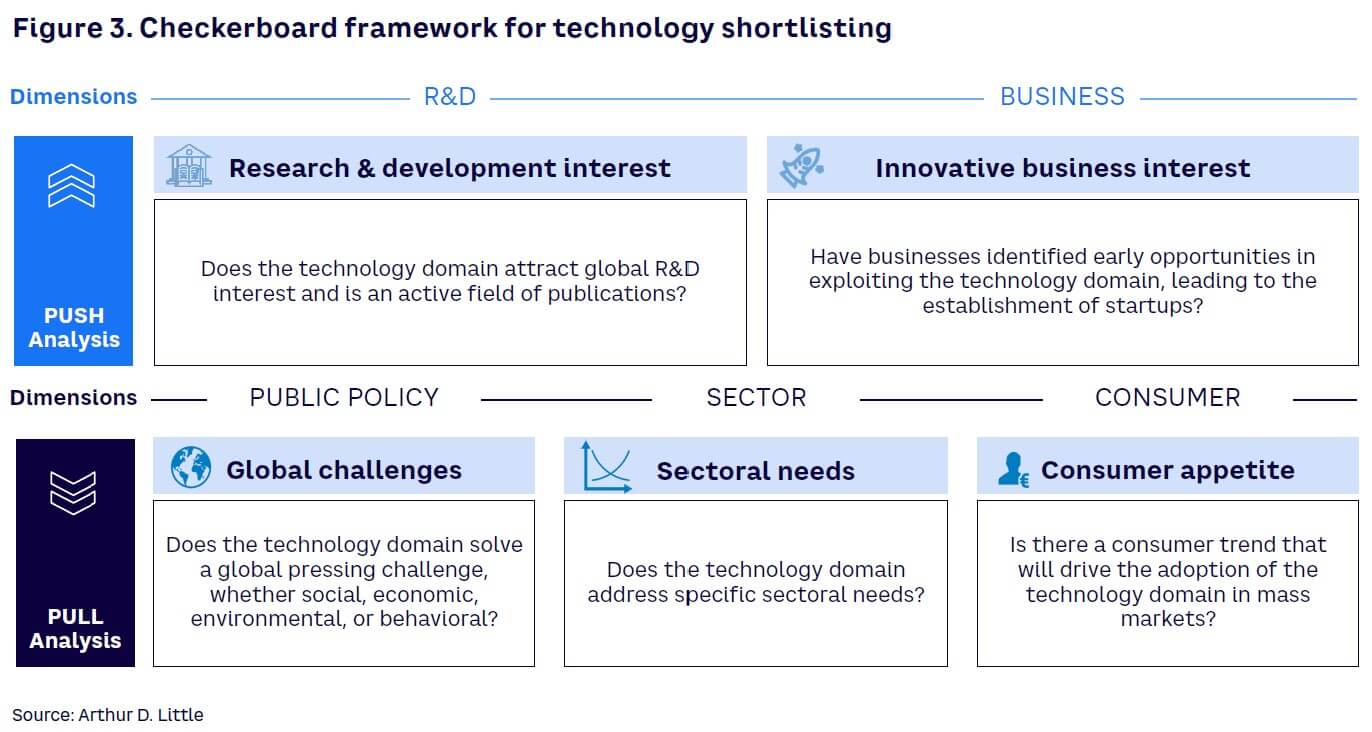
THE GROWING IMPORTANCE OF TECHNOLOGY FORESIGHT
What is technology foresight?
First popularized in the 1970s by countries such as Japan, technology foresight helps countries to engage with uncertainty and complexity and select promising technologies for longer-term development. Defined by the United Nations Industrial Development Organization (UNIDO) as “the most upstream element of technology development,” technology foresight is a formalized process that many countries have used to successfully shape their long-term industrial policy and focus in support of broader national sectoral development agendas.
The key difference between technology foresight and other planning approaches is its long-term horizon (10-30 years) and broad remit, which considers all potential technologies in various stages of maturity. Foresight is usually conducted to identify technologies that can, in the long term, benefit the broader economy or entire sectors rather than individual actors.
Strong technology foresight programs do not seek only to forecast megatrends or breakthrough innovations, but also aim to identify incremental technology developments that can address currently unmet needs. Carried out correctly, they prevent countries from making fundamental mistakes, such as jumping on technology bandwagons where they are unlikely to derive value. Indeed, through its rigorous analysis, a technology foresight program can highlight not only where to focus, but also which areas they do not need to lead in, and which can be addressed as an adopter of technology.
Why technology foresight is now more important than ever
Today we live in a world driven by three, interconnected trends:
- Technology innovation converging increasingly across all sectors at both an incremental and breakthrough level.
- Greater “winner takes all” competition between countries when it comes to leveraging disruptive technologies for comparative advantage.
- The growing need to overcome a wide range of global challenges, such as climate change and pollution. (Figure 1 summarizes global challenges currently listed as priorities by organizations including the UN, the World Economic Forum, The Millennium Project, and the G20.)

All of these trends make the need for technology foresight a key priority, leading countries as diverse as South Africa, Norway, and Saudi Arabia to launch programs over the last decade. Technology foresight enables countries to choose between an almost infinite number of technology options, condensing them into a manageable set of attractive possibilities. These options should be relevant to their wider aims and needs and build on their existing strengths. Successful technology foresight underpins strong economic development, enabling countries to compete with global rivals, potentially through first-mover advantage, all while scaling innovation to prevail over future global challenges. Economies that have achieved success in using technology foresight to build positions of strength in key areas and industries include the US, Germany, UK, Japan, Korea, and China.
Countries have adopted a variety of approaches for technology foresight, ranging from a purely qualitative approach that relies heavily on expert interviews to more data-driven, quantitative methods. For example, it is now possible to comprehensively analyze the number of patents, publications, or startups focused on a specific technology to understand longer-term opportunities. Foresight exercises normally combine multiple approaches to deliver a balanced methodology.
10 STRATEGIC IMPERATIVES FOR TECHNOLOGY FORESIGHT
There are multiple approaches to running effective technology foresight exercises, each with its strengths and weaknesses. The “right approach” will therefore vary, depending on the particular needs, maturity, and situation of the country concerned. However, we have found 10 best practices that every technology foresight program should follow to maximize its chances of success.
1. Take a horizon-centric approach
Technology foresight exercises can cover multiple, distinct horizons. Depending on the industry sector, forecasting can look from 10-15 years ahead, with foresight covering longer-term horizons of 15-30 years. These two time horizons serve different purposes. Forecasting helps align active research, development, and innovation (RDI) efforts and identify economic focus areas for the current development of a nation, while foresight helps set its long-term RDI agenda and identify disruptive technologies that can shape its long-term future economy.
Technologies being considered in a mid-term forecast track already will have emerged and been at least partially developed, making them easier to spot and analyze. Looking further into the future introduces greater uncertainty, as such technologies are unlikely to have moved beyond theory or even the realms of science fiction. What is important is to identify the horizon you are working to and adapt your approach accordingly.
2. Align to your national needs and strengths
Technology foresight can identify a wide range of opportunities. However, a country is unlikely to be successful in implementing those opportunities if they do not fit with or contribute to existing national innovation, economic, and industrial policies, as well as current strengths. For example, focusing on an in-demand technology such as quantum computing requires existing academic and research capabilities that would be difficult to build from zero.
The results of technology foresight exercises therefore must align with a country’s economic vision, sociocultural context, comparative advantages, and overall industrial base. Determining how these promising technologies can be leveraged and used to nurture new opportunities that can create national strengths, particularly in their early stages, is key. Encouraging public-led innovation at a national level will create greater alignment between resources and effort, building confidence among companies, organizations, and institutions about the overall direction of innovation.
3. Be pragmatic to achieve results
Technology foresight exercises can rapidly encounter a plethora of logistical and stakeholder-driven complexities, ranging from the sheer amount of effort required to analyze an ever-expanding universe of available technologies to coordinating with a multitude of stakeholders and experts. It is therefore important to define expectations, timelines, and budgets for the exercise early on. Putting these constraints in place sets the level of granularity for technology foresight outputs to ensure they can be applied. If required, a phased approach can be taken with short-listing stages to meet budget and time constraints. By taking a pragmatic approach, policy makers can avoid the pitfall of delivering an intellectual exercise that has limited applicability in the real world. Figure 2 presents Arthur D. Little’s (ADL’s) gated approach for technology forecast and foresight that leads to the most promising technology domains per critical national sector in a pragmatic, time-bound manner.

4. Balance market pull and innovation push
Technological advances achieve success through a combination of drivers. They can be pushed by research and development or pulled by an expressed market need. A prime example of push is the EU’s €1 billion project to commercialize research into graphene. The Graphene Flagship initiative aims to make Europe the hub for the development of new technologies around the material. In contrast, the market need for low-cost, renewable energy has dramatically pulled down the cost of solar photovoltaic (PV) cells, stimulating rapid growth and adoption of the technology. Foresight exercises, as shown in Figure 3, must understand and consider both drivers to avoid missing potential breakthrough innovations.

5. Select a mix of qualitative and quantitative criteria
Technology foresight is an exercise in carefully balancing intelligent extrapolation with known facts. That means it requires a careful mix of qualitative and quantitative inputs, based on the exercise’s time horizon and specific aims:
- Qualitative data is opinion-driven, contributed by experts, so is naturally subject to bias and potential groupthink. However, it can uncover breakthrough innovations, making it better suited for long-term foresights where actual information is not available.
- Quantitative data is more objective and rooted in fact, making it applicable to short-term foresight or forecast, around areas where sufficient data is available. While it avoids bias, it does not allow the scoping of more speculative ideas with longer-term horizons due to a lack of information.
6. Adopt a holistic view of indicators
Measuring the potential of particular technologies or sectors requires selecting relevant indicators, such as patent applications, funding, startup formation, or research publications. These need to be analyzed holistically, rather than individually, so you can give a proper weighting to each one. For example, a growth in patents alone does not necessarily mean a technology will break through into the mainstream. Instead, the foresight exercise should go deeper and combine this analysis with other indicators such as the number of publications being written, the amount of funding that has been directed toward a topic, and the momentum of interest in the startup community. The intricate combination of these leading and lagging indicators provides a far more indicative vision of the future than a more siloed study.
7. Be consistent in your comparisons
You can only properly understand where different technologies sit in your foresight exercise by evaluating them consistently at the right level. Defining clear technology hierarchies, with families and systems, will allow making relevant comparisons at the same level of granularity to deliver relevant results. For example, you cannot compare the broad topic of nuclear energy with the more granular one of perovskite solar cells, simply because broader topics would naturally capture more indicators. You can reach meaningful conclusions only by comparing like with like.
8. Understand sectoral nuances
Every sector has its own specific nuances when it comes to highlighting technological developments. Some industries may be less open to sharing knowledge, restricting the amount of information disseminated through publications, while others more readily publish their latest findings. In aerospace, for instance, there is a much greater emphasis on patents and intellectual capital protection than there is in the energy sector, where publishing papers is much more the norm for disseminating information about new innovations. Policy makers should understand and account for these differences when making choices — a one-size-fits-all approach will certainly not be effective.
9. Ensure expert input is unbiased
Experts will provide a large part of the content for any foresight exercise, particularly when it comes to qualitative data. It is therefore imperative that their input remains as unbiased as possible. Every effort must be made to avoid conflicts of interest that might skew any conclusions, requiring detailed background research and a full disclosure of any factors that could potentially introduce bias. Given that bias may still creep in, the methodology and analysis must be designed and carried out in such a way as to understand and mitigate its potential impact on the overall results.
10. Make it an ongoing process
Conducting technology foresight is not a one-off event that produces a report, but the precursor to taking strategic action. Align the results of the exercise with key stakeholders after it has been completed to ensure implementation and forward progress. This includes using language accessible to decision makers and highlighting clear links between foresight topics and the wider policy agenda.
Technology foresight must be ongoing, with reports updated regularly, dependent on the time horizons and sector. Failing to repeat foresight exercises often enough or at the appropriate time means you will be slower to spot, or may even miss completely, breakthrough technologies, changes in your market, or unexpected events. There must be a regular, timetabled program of “technology scouting” to capture the most current list of promising technology areas within a given sector, followed by a phase of evaluation and validation to create a short list of those offering the greatest potential.
Conclusion
Follow best practice to drive technology foresight success
Successful technology foresight programs are a useful tool to deliver value. While foresight exercises are essentially speculative in nature, they can act as self-fulfilling prophecies, driving national efforts toward the adoption of technologies that otherwise would have been left out. To adopt them successfully, countries should consider following best practice, including:
- Pick the right methodology for your specific requirements.
- Balance market pull and innovation push to avoid missing promising breakthrough innovations.
- Be clear on time horizons to choose the right approach.
- Align with the wider national agenda.
- Account for expert bias to avoid a skewed, or incomplete, range of possibilities.
- Guard against reports becoming “shelfware” by ensuring foresight leads to action.
- Set a regular frequency for foresight exercises to remain current.
*Acknowledgment: Dr. Abdulaziz Almalik and Abdulaziz Alsuwailem are, respectively, Director General of Research and Innovation Support and Director of the Technology Forecast Center at the King Abdulaziz City for Science and Technology (KACST), Riyadh, Kingdom of Saudi Arabia.





